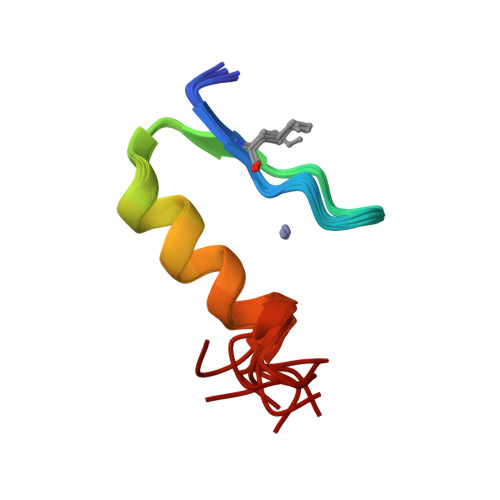Proteomimetic Zinc Finger Domains with Modified Metal-binding beta-Turns.
Rao, S.R., Horne, W.S.(2020) Pept Sci (Hoboken) 112
- PubMed: 33733039
- DOI: https://doi.org/10.1002/pep2.24177
- Primary Citation of Related Structures:
6PV0, 6PV1, 6PV2, 6PV3, 6UCO, 6UCP - PubMed Abstract:
The mimicry of protein tertiary folds by chains artificial in backbone chemical composition leads to proteomimetic analogues with potential utility as bioactive agents and as tools to shed light on biomacromolecule behavior. Notable successes toward such molecules have been achieved; however, as protein structural diversity is vast, design principles must be continually honed as they are applied to new prototype folding patterns. One specific structure where a gap remains in understanding how to effectively generate modified backbone analogues is the metal-binding β-turn found in zinc finger domains. Literature precedent suggests several factors that may act in concert, including the artificial moiety used to modify the turn, the sequence in which it is applied, and modifications present elsewhere in the domain. Here, we report efforts to gain insights into these issues and leverage these insights to construct a zinc finger mimetic with backbone modifications throughout its constituent secondary structures. We first conduct a systematic comparison of four turn mimetics in a common host sequence, quantifying relative efficacy for use in a metal-binding context. We go on to construct a proteomimetic zinc finger domain in which the helix, strands, and turn are simultaneously modified, resulting in a variant with 23% artificial residues, a tertiary fold indistinguishable from the prototype, and a folded stability comparable to the natural backbone on which the variant is based. Collectively, the results reported provide new insights into the effects of backbone modification on structure and stability of metal-binding domains and help inform the design of metalloprotein mimetics.
Organizational Affiliation:
Department of Chemistry, University of Pittsburgh, 219 Parkman Avenue, Pittsburgh, PA 15260, USA.


















